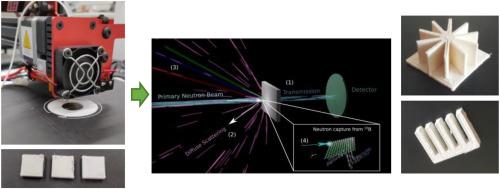Composites Science and Technology ( IF 8.3 ) Pub Date : 2022-12-14 , DOI: 10.1016/j.compscitech.2022.109876 Jonathan C. Knott , Hadis Khakbaz , Jackson Allen , Liang Wu , Richard A. Mole , Christopher Baldwin , Andrew Nelson , Anna Sokolova , Stephen Beirne , Peter C. Innis , Dillon Frost , David Cortie , Kirrily C. Rule

|
Functional polymer composites can confer a range of benefits in practical applications that go beyond the individual properties of the constituent materials. Here we investigate and characterize the neutron absorbing capability of few-layer hexagonal boron nitride (h-BN) in composite with a 3D-printable thermoplastic polyurethane, and present experiment and simulation data to understand the processes and mechanisms in play. Shielding and protection from neutrons can be necessary in a range of terrestrial and space-based applications. The neutron absorption of composites with varying fractions of h-BN is strongly energy-dependent in the low-energy regime below 10 meV, and a composite containing 20 wt% h-BN shows a 70-fold reduction in the transmission relative to pure polyurethane at 0.5 meV neutron energies. This is attributed to the strong neutron capture cross-section of the naturally abundant boron-10 isotope, with energy-dependent measurements up to 100 meV confirming this point. Using inelastic neutron spectroscopy, we identify additional effects from the hydrogen in the polyurethane which both scatters diffusively and moderates neutrons inelastically via its phonon spectrum, enhancing the neutron absorption characteristics. Two models – based on analytic functions and Monte Carlo numerical techniques – are presented, and show excellent agreement with experiment results. The 3D-printability of the composite is demonstrated, and the opportunities and challenges for deploying these composites in neutron radiation protection applications are discussed.
中文翻译:

用于中子辐射屏蔽应用的少层六方氮化硼/3D 打印聚氨酯复合材料
功能性聚合物复合材料在实际应用中可以带来一系列好处,这些好处超出了组成材料的个别特性。在这里,我们研究并表征了少层六方氮化硼 ( h -BN) 在与可 3D 打印的热塑性聚氨酯复合材料中的中子吸收能力,并提供了实验和模拟数据以了解其中的过程和机制。在一系列地面和太空应用中,可能需要屏蔽和保护免受中子的影响。具有不同分数的h -BN 的复合材料的中子吸收在低于 10 meV 的低能量状态下强烈依赖于能量,并且含有 20 wt% h的复合材料-BN 在 0.5 meV 中子能量下显示相对于纯聚氨酯的传输减少 70 倍。这归因于天然丰富的硼 10 同位素的强中子俘获截面,高达 100 meV 的能量相关测量证实了这一点。使用非弹性中子能谱,我们确定了聚氨酯中氢的额外影响,它通过其声子光谱扩散散射和非弹性地调节中子,增强了中子吸收特性。提出了两个模型——基于解析函数和蒙特卡洛数值技术——与实验结果非常吻合。证明了复合材料的 3D 打印能力,


















































 京公网安备 11010802027423号
京公网安备 11010802027423号